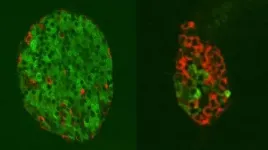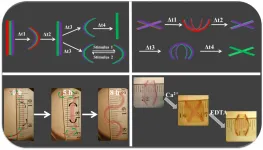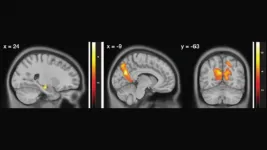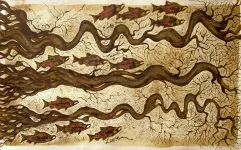Swapping alpha cells for beta cells to treat diabetes
Antibodies that convert glucagon-producing cells into insulin-producing ones cure mouse models of the disease
2021-03-01
(Press-News.org) Blocking cell receptors for glucagon, the counter-hormone to insulin, cured mouse models of diabetes by converting glucagon-producing cells into insulin producers instead, a team led by UT Southwestern reports in a new study. The END
ELSE PRESS RELEASES FROM THIS DATE:
Globally most pregnant women, mothers would get COVID-19 vaccine, vaccinate their children
2021-03-01
Boston, MA--Most pregnant women and mothers of children younger than 18 years old say they would receive a COVID-19 vaccine and vaccinate their children, according to a survey conducted by researchers at Harvard T.H. Chan School of Public Health. The research indicated that vaccine acceptance was highest in India, the Philippines, and all sampled countries in Latin America, and it was lowest in Russia, the U.S., and Australia.
The results will be published online on March 1, 2021 in the European Journal of Epidemiology.
Vaccines for COVID-19 are being distributed around the world, but until ...
New MHRP pre-clinical SHIV remission study shows progress in delaying viral load rebound
2021-03-01
SILVER SPRING, Md. - A recent preclinical study by U.S. Military HIV Research Program (MHRP) researchers showed that an experimental therapy combining a TLR7 agonist and two broadly neutralizing antibodies delayed viral rebound in SHIV-infected macaques after antiretroviral therapy (ART) interruption.
The experimental combination therapy consisted of TLR7 agonist GS-986 and two broadly neutralizing antibodies (bnAbs), N6-LS and PGT121, targeting different regions of the HIV envelope. The rhesus macaques were initiated on viral suppressive antiretroviral therapy 14 days post infection, a timespan from infection to treatment which mirrors what is feasible in acute HIV infection. Researchers then administered the experimental combination ...
Why some melanoma patients do not respond to immunotherapy
2021-03-01
NEW YORK, NY (March 1, 2021)--By harnessing the immune system against cancer, immunotherapies have revolutionized the way some types of cancer are treated. But most patients--across cancer types--do not respond, and in most cases, scientists are at a loss as to why.
Researchers at Columbia and MIT have created a new technique that can uncover nearly all of the tricks cancer cells use to evade immunotherapies, which could lead to the development of more effective treatments.
The researchers tested their new technique with cancer cells and matching immune cells from melanoma patients and identified previously unknown resistance mechanisms to immune checkpoint ...
Black Americans report high levels of vaccine hesitancy
2021-03-01
Black Americans have a high level of vaccine hesitancy and mistrust of COVID-19 vaccines, including among Black health care workers, according to a new RAND Corporation survey.
Those who expressed vaccine hesitancy also showed high levels of overall mistrust in the vaccine, concerns about potential harm and side effects, and lack of confidence in vaccine effectiveness and safety.
Participants in the RAND survey reported higher trust in COVID-19 information from health care providers and public health officials than from elected local and federal officials.
The findings are based on a survey ...
4D bioengineering materials bend, curve like natural tissue
2021-03-01
Tissue engineering has long-depended on geometrically static scaffolds seeded with cells in the lab to create new tissues and even organs. The scaffolding material -- usually a biodegradable polymer structure -- is supplied with cells and the cells, if supplied with the right nutrients, then develop into tissue as the underlying scaffold biodegrades. But this model ignores the extraordinarily dynamic morphological processes that underlie the natural development of tissues.
Now, researchers at the END ...
Deep dive into bioarchaeological data reveals Mediterranean migration trends over 8,000 years
2021-03-01
A team of international researchers led by a Florida State University assistant professor has analyzed reams of data from the Neolithic to Late Roman period looking at migration patterns across the Mediterranean and found that despite evidence of cultural connections, there's little evidence of massive migration across the region.
"Because of the prevailing scholarly attitude of the 'connected' Mediterranean -- one with high degrees of mobility and migration that drive the archaeological patterns we see -- we'd imagined we'd see comparatively high levels of migration reflected in the strontium isotope data," said Thomas Leppard, assistant professor of anthropology at Florida State. "That instead ...
A research group proposes six guidelines for managing the impacts of invasive species
2021-03-01
Invasive alien species, defined as animals and plants that breed and disperse in a landscape beyond their native range, have negative environmental, social, and economic impacts. One example among many is the forage grass genus Brachiaria, originally African and introduced to Brazil to form cattle pasture. It has become a major threat to the survival of native species and biodiversity at several spatial scales.
Complete eradication of invasive species is often impracticable. Attempts to do so have had undesirable consequences and even been damaging because merely withdrawing an invasive ...
Noisy brain activity contributes to aging-related navigation impairments
2021-03-01
Too much activity in the hippocampus may cause navigation impairments seen in aging adults, according to new research published in JNeurosci.
Spatial navigation is one of the cognitive abilities that declines sharply in old age. Older adults often have difficulty navigating new environments and will choose to stick with familiar ones. Plus, key regions in the brain's navigation circuit are some of the first affected by Alzheimer's disease. In a recent study, Diersch et al. examined the neural mechanism behind this decline in spatial learning.
In the study, younger ...
Addressing a complex world of pain in a single gene difference
2021-03-01
A single letter difference in a single gene, inherited from both parents, spells a lifetime of anemia and pain for 20 million people, mostly of African ancestry, worldwide. Sickle cell disease (SCD) causes red blood cells to assume a sickle shape and jam in capillaries, cutting off oxygen to lungs, brain, bones and other organs. Despite the single genetic origin of SCD, each person's disease experience and even life expectancy depend upon where they live, and the social, physical and environmental factors they encounter.
Now, a new review published by Wiley in the journal Advanced Genetics proposes that it is ...
Scientists describe 'hidden biodiversity crisis' as variation within species is lost
2021-03-01
The rapid loss of variation within species is a hidden biodiversity crisis, according to the authors of a new study looking at how this variation supports essential ecological functions and the benefits nature provides for people.
Published March 1 in Nature Ecology and Evolution, the study highlights the need to better understand and conserve variation within species in order to safeguard nature's contributions to people.
"Biodiversity means more than the number of species, and when we focus on species-level extinctions we are missing part of the story," said corresponding author Eric Palkovacs, professor of ecology and evolutionary biology at UC Santa Cruz. "Intraspecific variation is a neglected aspect of biodiversity, ...
LAST 30 PRESS RELEASES:
Boosting the cell’s own cleanup
Movement matters: Light activity led to better survival in diabetes, heart, kidney disease
Method developed to identify best treatment combinations for glioblastoma based on unique cellular targets
Self-guided behavioral app helps children with epilepsy sleep earlier
Higher consumption of food preservatives is associated with an increased risk of type 2 diabetes
NTU Singapore-led team captures first-ever ‘twitch’ of the eye’s night-vision cells as they detect light, paving the way for earlier detection of blindness-causing diseases
Global aviation emissions could be halved through maximising efficiency gains, new study shows
Fewer layovers, better-connected airports, more firm growth
Exposure to natural light improves metabolic health
As we age, immune cells protect the spinal cord
New expert guidance urges caution before surgery for patients with treatment-resistant constipation
Solar hydrogen can now be produced efficiently without the scarce metal platinum
Sleeping in on weekends may help boost teens’ mental health
Study: Teens use cellphones for an hour a day at school
After more than two years of war, Palestinian children are hungry, denied education and “like the living dead”
The untold story of life with Prader-Willi syndrome - according to the siblings who live it
How the parasite that ‘gave up sex’ found more hosts – and why its victory won’t last
When is it time to jump? The boiling frog problem of AI use in physics education
Twitter data reveals partisan divide in understanding why pollen season's getting worse
AI is quick but risky for updating old software
Revolutionizing biosecurity: new multi-omics framework to transform invasive species management
From ancient herb to modern medicine: new review unveils the multi-targeted healing potential of Borago officinalis
Building a global scientific community: Biological Diversity Journal announces dual recruitment of Editorial Board and Youth Editorial Board members
Microbes that break down antibiotics help protect ecosystems under drug pollution
Smart biochar that remembers pollutants offers a new way to clean water and recycle biomass
Rice genes matter more than domestication in shaping plant microbiomes
Ticking time bomb: Some farmers report as many as 70 tick encounters over a 6-month period
Turning garden and crop waste into plastics
Scientists discover ‘platypus galaxies’ in the early universe
Seeing thyroid cancer in a new light: when AI meets label-free imaging in the operating room
[Press-News.org] Swapping alpha cells for beta cells to treat diabetesAntibodies that convert glucagon-producing cells into insulin-producing ones cure mouse models of the disease





